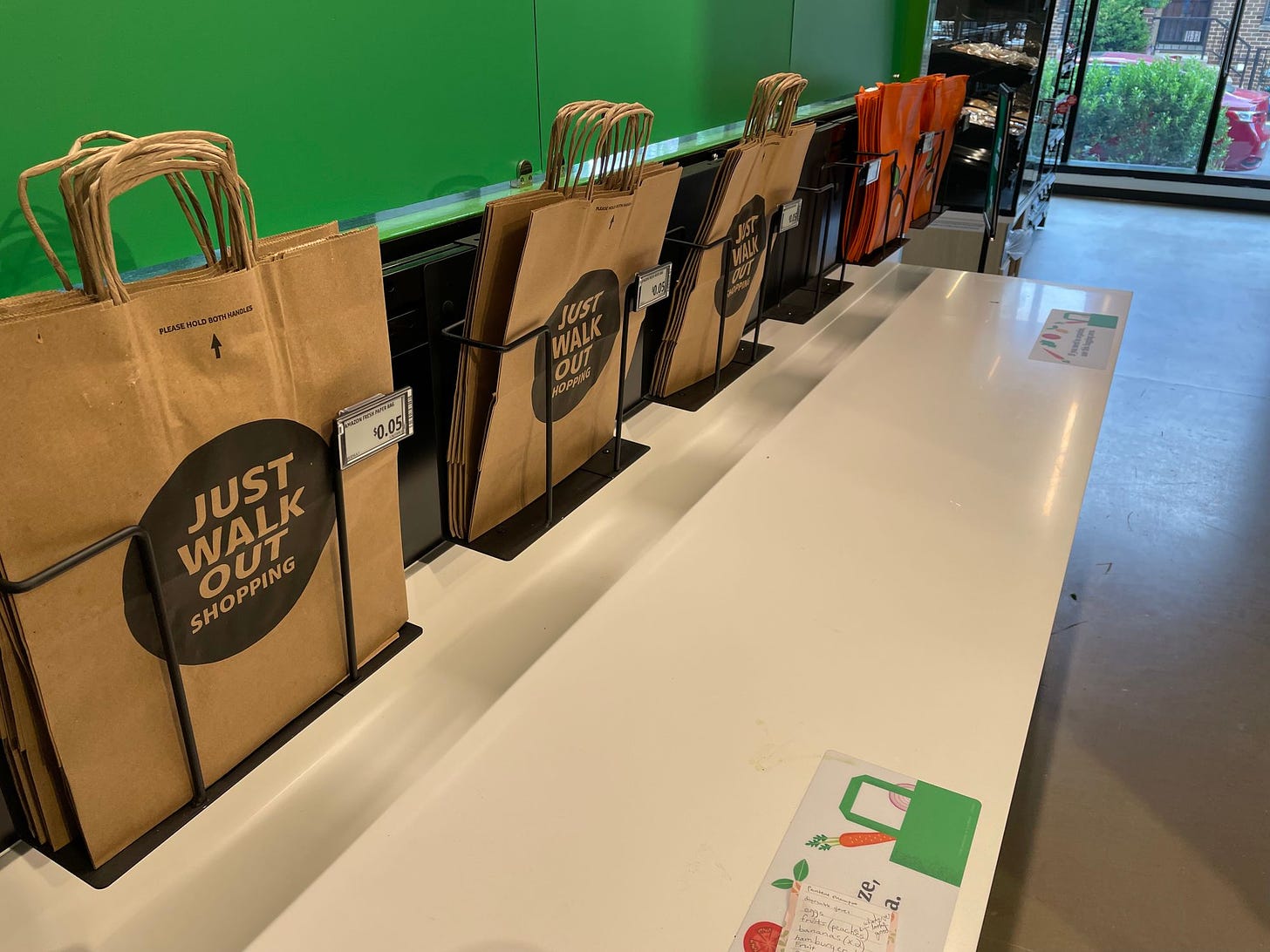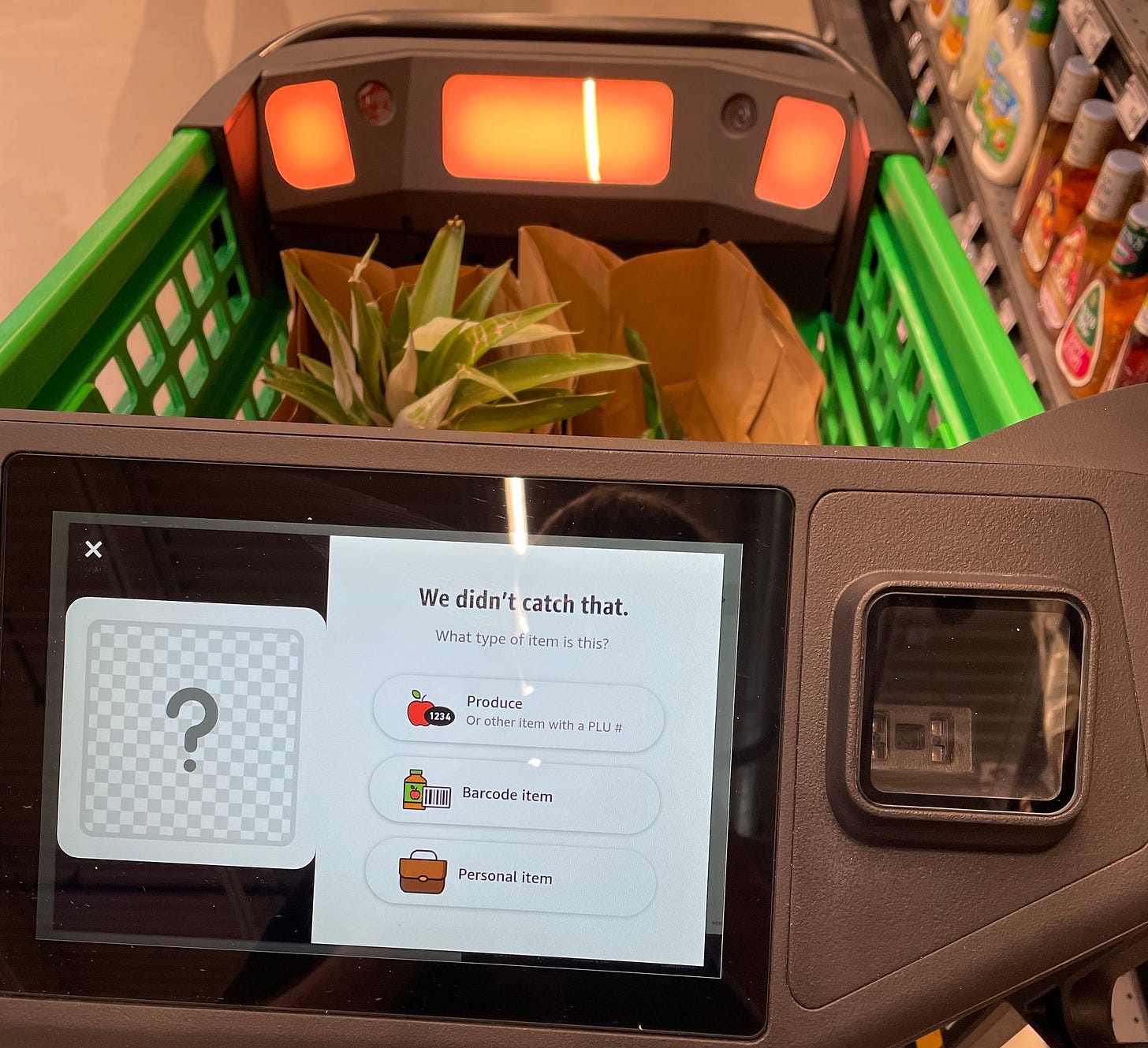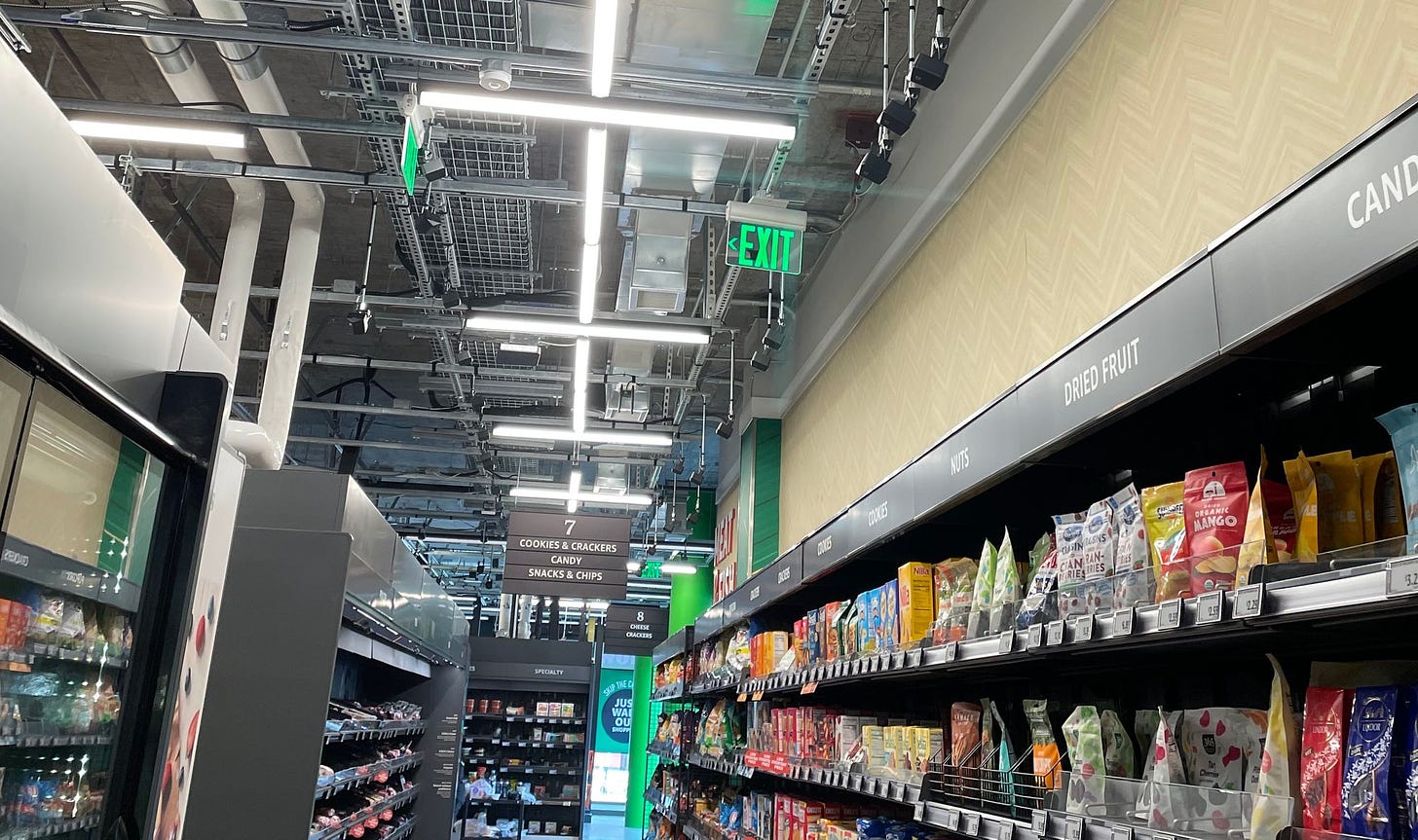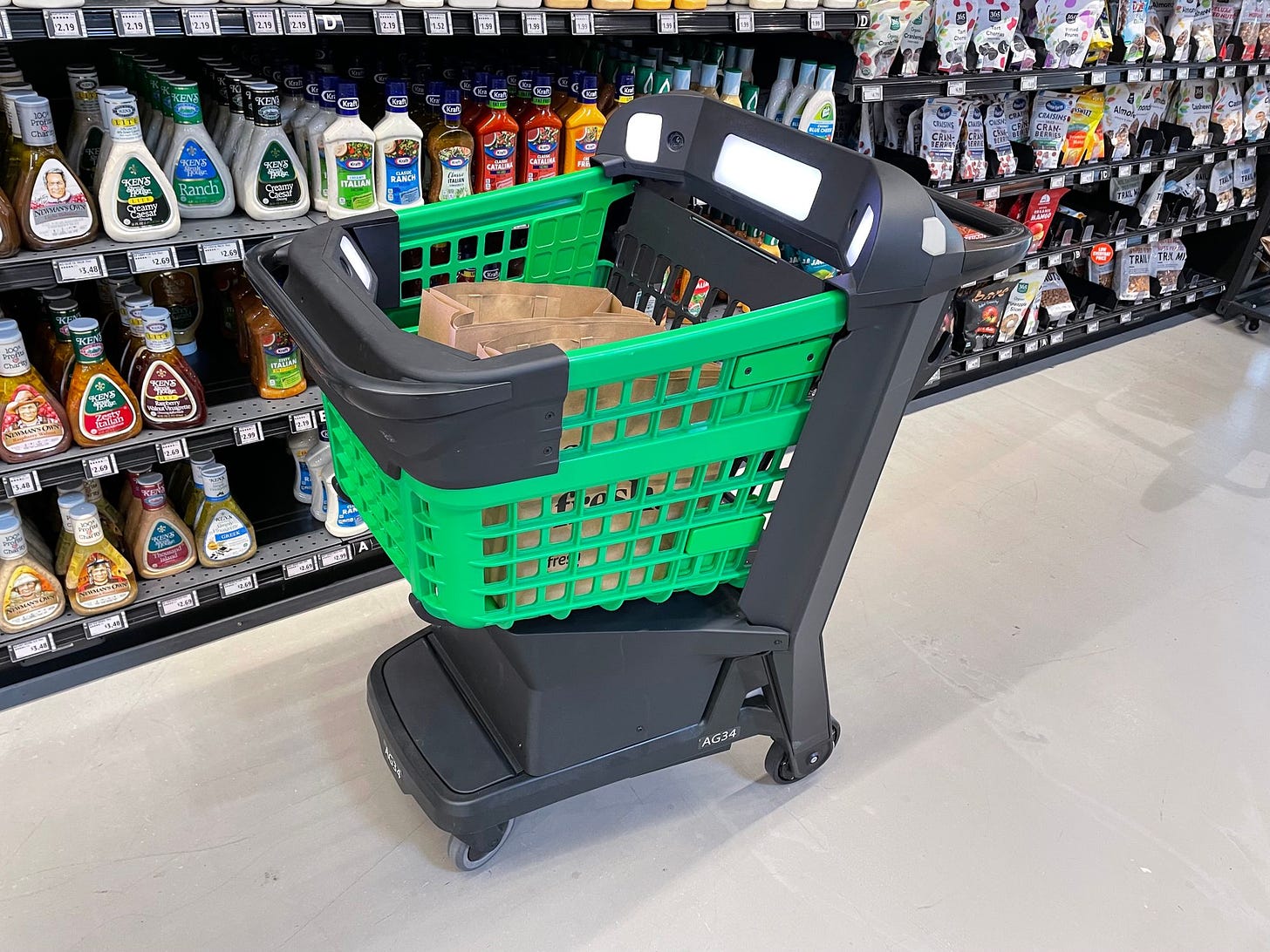What I learned visiting two cutting-edge Amazon grocery stores
Grocery stores have reason to worry as Amazon invades their industry.

Amazon’s assault on the grocery industry arrived in my hometown of Washington DC last month. A new Amazon Fresh store opened in the upscale Logan Circle neighborhood—one of dozens of stores Amazon is expected to open in the coming months across the United States.
The DC store is notable because it’s one of the first Amazon Fresh stores to feature Amazon’s Just Walk Out technology. Cameras, weight sensors, and sophisticated software enable customers to grab the items they want and leave, skipping the checkout process entirely. Amazon debuted the technology for smaller Amazon Go convenience stores a few years ago, and is now starting to use it for larger stores.
For this story I visited two Amazon fresh stores—the DC store with Just Walk Out technology and a second store in the Virginia suburbs. The Virginia store uses a different checkout technology called a Dash Cart. As we’ll see, the Just Walk Out technology worked well, while the Dash Cart left a lot to be desired.
Amazon’s extensive knowledge and experience running complex supply chains—and owning Whole Foods over the last four years—would make it a formidable competitor even without its Just Walk Out technology. Add in the no-checkout technology, and incumbent supermarkets have a lot of reasons to worry.
It’s a perfect time for Amazon to get into groceries
The last 18 months have been a time of rapid change for the grocery industry. There are three key trends, new to the COVID-19 era, that all work to Amazon’s advantage: high demand, cheaper commercial real estate, and high labor costs.
In March 2020, grocery stores faced unprecedented levels of demand. Even after this initial wave of pandemic panic buying subsided, demand stayed higher than pre-pandemic levels as people shifted from eating out to making meals at home.
And while some Americans struggled financially during the pandemic, many others emerged with strong household finances. Many people kept their jobs even as they cut back spending on night life and travel, resulting in extra savings. Those who lost their jobs received unusually generous unemployment benefits, sometimes more than they were previously earning. Then the federal government sent almost everyone stimulus checks. The result: many consumers have extra cash to spend, and they’re spending it. Grocery stores benefit from an overall increase in demand in the economy, as well a rising market share relative to restaurants.
As the grocery business and household incomes have thrived, restaurants, bars, and many other types of retail businesses have struggled. Some were forced to shut down. The economy is now recovering, but there’s still a glut of vacant commercial real estate in urban neighborhoods like DC’s Logan Circle.

This softness of the commercial real estate market helps Amazon keep its costs down. Grocery industry analyst Lou Scudere has found that Amazon is locating Fresh stores in “second use” sites where they take over the lease of another retailer. This not only saves Amazon on build-out costs, it also gives Amazon leverage as it negotiates rents and lease terms with landlords.
A final feature of the economy that works to Amazon’s benefit is the tight labor market. Many retail businesses with relatively low wages, including some of Amazon’s competitors, have struggled to attract workers recently. Amazon’s no-checkout technology will help Amazon cope, and give it a substantial edge relative to its competitors. Industry analyst Bill Bishop estimates that checkout labor costs eat up 8 to 10 percent of a typical grocery store’s revenues, so the potential savings here are large.
Amazon is emphasizing convenience more than low prices
I visited the Washington DC Amazon Fresh store on Monday, August 2 with a shopping list of about a dozen items. You use the Amazon app to bring up a QR code and scan this code at the entrance. Then you put away your phone and start shopping. When you’re done, you “just walk out” and Amazon emails you a receipt.
At 7,300 square feet, the DC store is larger than most convenience stores (including Amazon’s own Go convenience stores that use the same technology) but much smaller than a full-sized grocery store. Amazon’s store was missing buttermilk and Wheaties, and it didn’t have non-food items like dental floss. But it had all the other items I wanted, including a good selection of fruit and meat.
This style of store—smaller than a full-sized grocery store, with an emphasis on perishable and premium items—is fairly common in upscale DC neighborhoods. In fact, there are a couple of stores like it just a few blocks north of the Amazon Fresh. Stores like this cater to affluent customers who live right nearby—people who need just a few items and are willing to pay a premium to avoid a longer trip. Like those other stores, DC’s Amazon Fresh store offers high quality produce and meats and a fair number of pre-made options.
After going to Amazon Fresh, I comparison-shopped at my usual grocery store, a Harris Teeter. I found Amazon’s prices were competitive with this conventional, full-size grocery store.
On average, I found Amazon’s prices were slightly lower than Harris Teeter’s, though the difference was small enough that I’m going to call it a tie.
Amazon’s no-checkout technology helps in several ways here. Obviously, buying groceries is more convenient if you don’t have to wait in a checkout line. Equally obvious, Amazon can pass along the money it saves by not having checkout clerks.
More subtly, removing checkout counters allows the stores to be smaller—not only because you don’t need the physical space for the checkout lanes, but also because you don’t need a large volume of business to recoup the fixed cost of running the checkout lanes. So instead of having a single big store, Amazon could profitably build several small stores to serve the same area. That would mean more customers living within easy walking distance of an Amazon Fresh store—customers who might get in the habit of stopping by Amazon Fresh stores every day or two for fruit, milk, and other perishables.
Dash Cart disaster
The DC region’s other Amazon Fresh location is in Franconia, Virginia, about 30 minutes southwest of the nation’s capital. I visited it on Monday, August 9. In contrast to the DC location, this one is a full-sized suburban grocery store. And this store doesn’t have Just Walk Out technology. It uses a totally different checkout technology called the Dash Cart, a high-tech grocery cart with a digital screen and several inward-facing cameras.
As you put an item into the cart, the cameras automatically spot the barcode and ring up the item. In theory this lets customers skip the checkout lane. In practice, the Dash Cart was more trouble than it was worth.
My Dash Cart was stumped by produce items that lack a barcode. I had to type in a four-digit price look-up (PLU) code. And the cart didn’t even have an on-screen directory of common PLU codes—a feature conventional supermarket self-checkout machines have had for years.

This is especially baffling because we know Amazon has the technology to recognize common grocery items using cameras! A better Dash Cart would be able to recognize that I put a bunch of bananas in my cart without a barcode. But evidently, Amazon hasn’t managed to transfer its image recognition capabilities from the Just Walk Out system to Dash Carts.
Another problem: Dash Carts are smaller than a regular shopping cart. It only fits two grocery bags, with room to slide a few items in around the sides. This wasn’t enough space for all the items I wanted to buy, so halfway through the shopping trip I parked my first cart and grabbed a second one.
Unfortunately, when I returned to my first cart, I found that I’d been logged out. In an email, an Amazon spokeswoman told me that this happens automatically if the cart is idle for too long. As a result, I lost all the data about the items in my cart. I had to take the cart to the front of the store and to be checked out the old-fashioned way.
Even if Amazon fixed the obvious flaws with the Dash Cart, it’s not clear that the technology is adding much value. My guess is that Amazon hasn’t yet figured out how to get Just Walk Out technology working at the scale of a full-sized grocery store, and the Dash Cart serves as a kind of stopgap.
But that should be temporary. Just Walk Out worked flawlessly for me in DC and offers a far better customer experience. It’s only a matter of time before Amazon scales it up for larger stores.
A home base for delivery
While I wasn’t a fan of the Dash Cart, I was impressed by the suburban store’s prices. As I did in DC, I compared the Franconia store’s prices to that of a nearby store—in this case a Giant supermarket. Amazon’s prices were dramatically lower. A basket of 14 products that cost $55.23 at Giant cost just $51.12 at Amazon Fresh—an impressive 7 percent savings.
Another remarkable thing about the Virginia store: it was swarming with Amazon employees. During my visit on a Monday afternoon, I saw more Amazon workers than I did regular customers. Most of them were carrying around hand-held scanners and filling shopping carts full of groceries—in other words, they appeared to be pickers for Amazon’s grocery delivery service.
In short, the Franconia store is effectively a delivery warehouse that lets customers visit. Industry analysts who have visited stores in other parts of the country have observed the same thing. Deliveries account for a much larger share of Amazon Fresh store sales than the sales of most grocery stores.
Interestingly, I didn’t observe many pickers at the DC Amazon Fresh location, but I suspect that’s temporary. It’s located in an affluent, high-density urban neighborhood, so I’m sure there are plenty of potential customers nearby. My guess is that the store is just so new that Amazon hasn’t started fully utilizing it for deliveries.
Grocers still have time to respond

The thing that should keep grocery industry leaders awake at night is that Amazon is attacking their industry on multiple fronts:
Matching—and in some cases decisively beating—incumbent grocery stores on price.
Using its stores and logistics expertise to provide fast and convenient delivery services.
Working to make in-person shopping more convenient with no-checkout technology.
The no-checkout technology seems to be the biggest wild card here. Even the largest grocery chains lack the resources and engineering expertise to build their own version of Amazon’s Just Walk Out technology. So if Amazon can scale up the technology to full-size grocery stores, it could provide a powerful competitive advantage.
But we shouldn’t count grocery incumbents out yet. For one thing, we don’t know how well Just Walk Out technology is really working. A couple of things give me pause.
I visited the DC Amazon Fresh location twice the week of August 2. Both times, it took Amazon about three hours to send me my receipt. I don’t know why it took Amazon so long to generate my receipt (the company didn’t answer an email seeking comment about this) but one possibility is that Amazon has human workers reviewing footage to make sure the software classified items correctly. Depending on how often this happens, it could negate a lot of the technology’s cost savings.
Another curious fact: Amazon seems to be scaling back its footprint for Amazon Go, the original chain of convenience stores based on Just Walk Out technology. Back in December 2019, Amazon had 25 Amazon Go locations. Today, that number has declined to 22 locations, with six of those listed as “temporarily closed.” This is particularly interesting because Bloomberg reported in 2018 that Amazon was planning to open up to 3,000 Amazon Go stores by 2021.
Maybe the Bloomberg report was mistaken, or maybe the pandemic forced Amazon to shutter stores for reasons unrelated to the Just Walk Out system. But Amazon isn’t acting like it has a game-changing retail technology that it’s eager to scale up. More broadly, Amazon’s foray into the grocery business seems somewhat half-hearted.
“It doesn't seem like they're moving terribly quickly with stores,” said Patrick Fisher, a DC-based grocery industry analyst. About a year after launch, there are only 17 Amazon Fresh locations. Fisher compared that with Aldi, a German supermarket chain that has been opening around 200 stores per year in recent years.
But Fisher argues that competitors shouldn’t be complacent. There’s every reason to think that mastering groceries is a long-term project for Amazon. Early problems with Amazon’s software will get fixed. And once Amazon is confident in its software and business model, it might start expanding more rapidly.
Fisher urged grocers to spend the next couple of years improving their delivery services—or launching one if they haven’t yet done so. Delivery is a big part of Amazon’s grocery strategy, with high delivery revenues helping to cover the fixed costs of running a store. So a grocery store without a delivery service will be at a competitive disadvantage if and when an Amazon store comes to their area.
Grocers may be able to license no-checkout technology

It’s also not obvious that grocery stores will need to build self-checkout technology themselves. I talked to Jordan Fisher, the CEO of Standard Cognition, a startup that’s working on its own no-checkout technology. Rather than building its own grocery stores, Standard plans to license its technology to existing stores.
The company’s technology is currently installed in four small convenience stores—a number the company expects to grow rapidly in the coming years. Jordan told me that one of its main customers, Compass Group, manages 15,000 retailers across North America.
Amazon carefully designs Amazon Go and Amazon Fresh stores to work with Just Walk Out technology. Products are spaced out on shelves for easy identification by cameras. Shelves at the Washington DC store have weight sensors under them to help the software to figure out which product a customer picked up.
In contrast, Standard Cognition is aiming to retrofit existing stores using only ceiling-mounted cameras. “We don't change your shelves, we don't change products, we don't put gates up,” Fisher told me.
And the technology doesn’t have to be perfect. Convenience stores already suffer a loss rate in the low single digits from customers stealing products, customers forgetting to pay, clerks forgetting to scan items, and so forth. Fisher said that Standard’s goal is for its technology to maintain or improve on this loss rate. The company is already achieving this goal in its pilot stores, according to Fisher.
However, Standard’s technology isn’t ready for full-size grocery stores yet. Fisher called the grocery industry “super interesting” but said the company is focused on smaller convenience stores for now. This is the same market Amazon started with back in 2018. So Amazon may have a substantial head start if it can get Just Walk Out technology working at supermarket scale.
While you can find fault with individual parts of Amazon’s strategy, the bottom line is that Amazon has vast resources and a corporate culture that values perseverance. If the company’s current grocery strategy doesn’t work, Amazon will adjust the strategy and try again.
Industry analyst Bill Bishop urged grocery stores to take the Amazon challenge seriously. “When I look around, I don't see a rush to invest, which I would interpret as not a very healthy sign,” Bishop told me.





